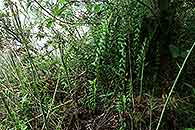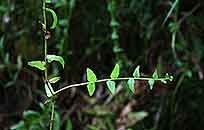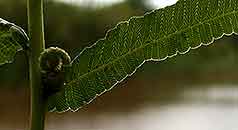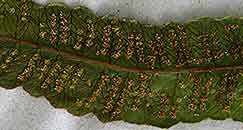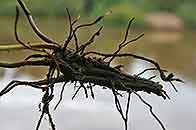Ampelopteris prolifera (Retz.) Copel.
Synonyms |
Goniopteris prolifera (Retz.) C.Presl |
|---|---|
Common name |
|
Description |
Rhizome long creeping, stout, up to 1 cm in diameter; rhizome scales triangular in outline, apex gradually tapering to a point, margins entire, up to 2 mm long, black. Fronds monomorphic, closely spaced, up to 1.2-1.4 m long, arching, proliferous at intervals along the rhachis, thinly coriaceous. Stipe up to 40 cm long, pale brown, hairless. Lamina pinnate, oblong to lanceolate in outline, apex of indefinite growth, lower 3-4 pairs of pinnae gradually reduced in size, up to 1 × 0.26 m, undersurface sparsely set with minute hairs, upper surface hairless; pinnae narrowly oblong in outline, shortly petiolate to sessile, apex pointed, base truncate, often with the basal acroscopic lobe overlapping the rhachis, margin shallowly incised into lobes with 5-7 pairs of veins anastomosing below the shallow sinus, 3-15 x 0.8-2 cm; rhachis pale brown, hairless. Sori round to elongated, situated along the veins, with paraphyses; exindusiate. |
Notes | Resembles Pneumatopteris unita which has a single gemmae positioned at the apex of the rhachis, an erect rhizome and 4-5 pairs of veins meeting below the sinus; this species is not found in full sun.
|
Derivation | prolifera: bearing plantlets; this plant produces adventituous shoots from the lamina. |
Habitat | Among grass, sedges, reed banks of Phragmites on banks of rivers, ponds or lakes in hot deciduous woodland, sometimes in light shade of riverine forest. |
Distribution worldwide | Africa, throughout the tropics of the old world to New Caledonia, New guinea and Australia, also Madagascar and Mascarene Islands. |
Distribution in Africa |
Angola, Botswana, Burundi, Dem. Republic of Congo, Equatorial Guinea (incl. Bioko), Guinea, Kenya, Malawi, Mozambique, Senegal, South Africa, Swaziland, Tanzania , Zambia, Zimbabwe. |
Growth form |
Terrestrial. |
Literature |
|
